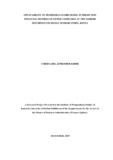APPLICABILITY OF PIOTROSKI F-SCORE MODEL IN PREDICTING FINANCIAL DISTRESS OF LISTED COMPANIES AT THE NAIROBI SECURITIES EXCHANGE 20 SHARE INDEX, KENYA
Abstract
Financial distress prospect is a key bother to the executives and different business partners for quite some time. The impact of financial distress and bankruptcy on firms is hard to the extent of ignoring it is impossible. Financial distress is not a selective event it attacks or can happen both too big organizations and small organizations. With the importance of securing financial health of our listed companies in Kenya is therefore important in anticipating the likelihood of fiscal distraint beforehand thus need for prediction and more so applying a reliable model in the prediction. This report focused on showing the utilization of Piotroski F-score framework in forecasting the economic or monetary depression among publicly quoted organizations particularly the NSE 20 Price Index firms for the period of two financial years that is 2016 and 2017. The study was also centered on Piotroski nine variables namely profitability signals, liquidity and leverage operational efficiency to show their interdependence with financial health /status of a company. The study utilized a descriptive survey approach targeting the NSE 20 Price Index firms which were mainly in service and commercial sector to investigate how elements used by Piotroski can help in determining the financial status of a company. The entire population of 20 firms was involved since this target population is manageable. Data were extracted from secondary sources for a period of the two financial years. The information gathered was dissected and synthesized utilizing illustrative and inferential measurements by applying SPSS as the supporting computer software. The results revealed that the organizations in the NSE and specifically the 20-Share Index firms placed steady outcomes as far as resources. The researcher derived that liquidity, leverage and source of assets are key determinants of fiscal strains among NSE recorded firms. The connection between fiscal strains and liquidity and leverage are emphatically related with fiscal strains suggesting that when liquidity and leverage go up, it will make the fiscal strains of firms at NSE to grow. The results inferred that the NSE 20-Share Index firms have moderately low fiscal strains. The organizations have commonly been effective in their tasks. Working productivity (operational efficiency) contributes more to diminish in fiscal strains of the organizations in the NSE-20-share list, trailed by profitability, while leverage and liquidity contributes the least to fiscal strains of the organizations in the NSE-20-Share Index. The examination prescribes that executives of NSE recorded firms to guarantee that the destinations of an organization are clung to from the underlying phase of advancement lifecycle of the organizations. The investigation prescribes reception of agreeable highlight to engage NSE recorded associations to use a bigger number of financial specialists' subsidizing than obligation and reduction the danger that is characteristic in the expanded usage of obligation. Firms ought to realize their ideal debt limit.

